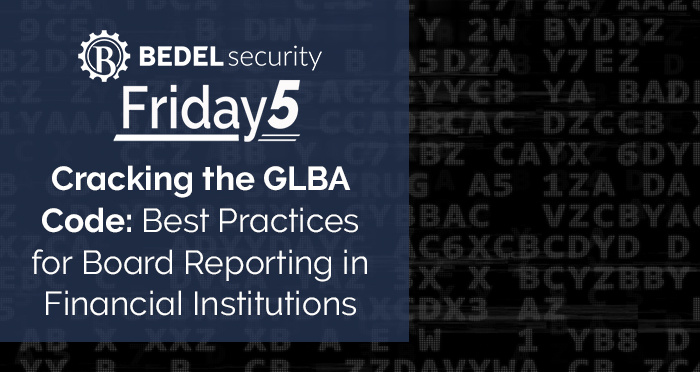The vCISO as a Business Enabler
When most people think of a Chief Information Security Officer (CISO), they imagine someone stationed at the front lines, safeguarding against any...
2 min read
Trisha Durkin : Aug 16, 2024


As an Information Security professional, you know that staying ahead of the regulatory curve is just part of the job. But when it comes to the Gramm-Leach-Bliley Act (GLBA), you’re not just playing for keeps; you’re reporting to the board. And let's be honest, crafting that perfect GLBA board report can feel a bit like assembling an IKEA bookshelf: it’s all about precision, attention to detail, and maybe a little bit of patience.
So, let’s dive into some best practices that will not only help you deliver an effective GLBA board report but also make you look like the rockstar you are.
Your board members are sharp, but they may not be fluent in cybersecurity jargon. Tailor your report to their level of understanding. Use clear, concise language and focus on the big picture. Think of it like explaining a complex financial instrument to a layperson: you’re not dumbing it down; you’re making it accessible.
The GLBA mandates that financial institutions safeguard sensitive customer information. Your report should clearly outline how your institution is meeting these requirements. Focus on the three pillars:
Numbers speak louder than words, especially to a board. Include relevant metrics that highlight the effectiveness of your information security program. These could include:
But remember, context is key. Don’t just throw numbers at them—explain what these metrics mean in terms of risk management and overall security posture.
Technical controls are critical, but people are your first line of defense. Highlight the importance of employee training and awareness programs. Show the board that your institution is not just investing in technology but also in cultivating a security-conscious culture. After all, the best firewall in the world won’t stop a phishing attack if your employees aren’t trained to spot one.
No security program is perfect. If there are areas where your institution is struggling to meet GLBA requirements, be upfront about it. The board needs to know where the risks lie so they can allocate resources effectively. Transparency builds trust and ensures that your security needs are taken seriously.
End your report with clear, actionable recommendations. Whether it’s increasing the budget for cybersecurity tools, expanding employee training programs, or focusing on emerging threats like AI-driven attacks, give the board a roadmap for the future. This shows that you’re not just maintaining the status quo but are proactively strengthening your institution’s security posture.
The GLBA board report is more than just a compliance requirement—it’s a strategic tool that helps your institution navigate the complex landscape of information security in the financial sector. By following these best practices, you can ensure that your report is not only compliant but also compelling, giving your board the insights they need to make informed, risk-based decisions.
And hey, maybe you’ll even get a nod of approval in the boardroom. After all, you’re not just reporting on security—you’re securing the future of your institution.

When most people think of a Chief Information Security Officer (CISO), they imagine someone stationed at the front lines, safeguarding against any...

“2024 was rough; why should 2025 be any different?” This is the mantra heard in many community banks and credit unions as they brace for the next...

If you are new to managing cybersecurity for a financial institution, I’m sure you’ll have a lot of questions. More specifically, “Where do I start?”